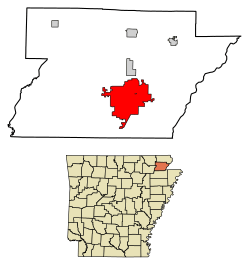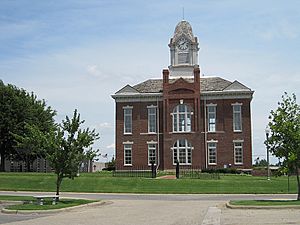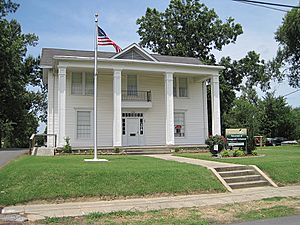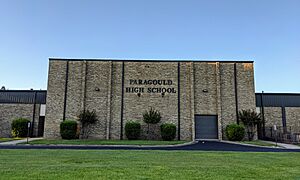Paragould, Arkansas facts for kids
Quick facts for kids
Paragould, Arkansas
|
||
|---|---|---|

South Pruett Street in Paragould
|
||
|
||

Location of Paragould in Greene County, Arkansas.
|
||
| Country | United States | |
| State | Arkansas | |
| County | Greene | |
| Area | ||
| • Total | 32.02 sq mi (82.93 km2) | |
| • Land | 31.86 sq mi (82.51 km2) | |
| • Water | 0.16 sq mi (0.42 km2) | |
| Elevation | 289 ft (88 m) | |
| Population
(2020)
|
||
| • Total | 29,537 | |
| • Density | 927.17/sq mi (357.99/km2) | |
| Time zone | UTC−6 (Central (CST)) | |
| • Summer (DST) | UTC−5 (CDT) | |
| ZIP codes |
72450-72451
|
|
| Area code(s) | 870 | |
| FIPS code | 05-53390 | |
| GNIS feature ID | 2404471 | |
Paragould is an important city in Arkansas, United States. It is the main city of Greene County. Paragould is located in the northeastern part of Arkansas. It sits on the eastern edge of Crowley's Ridge, which is a unique landform in the Arkansas Delta region.
Paragould is the largest city in its own Micropolitan Statistical Area. It is also part of a larger area called the Jonesboro-Paragould Combined Statistical Area. In 2020, about 29,537 people lived in Paragould. This was an increase from 26,113 people in 2010.
Contents
History of Paragould
The name "Paragould" comes from combining the last names of two important railroad leaders: J. W. Paramore and Jay Gould. Their two railroad lines, Paramore's Texas & St. Louis Railway and Gould's St. Louis, Iron Mountain and Southern Railway, met in this spot in 1882.
Local citizens chose this unique name. It is believed to be the only city in the world with this name. For a short time, Jay Gould did not like his name being second. He even refused to put the new town on his train schedules. In 1888, Paragould became the starting point for another railroad line. This line eventually reached Blytheville, Arkansas.
A Difficult Past: Sundown Town History
From 1888 to 1908, Paragould had a difficult history regarding its Black residents. During this time, Black people faced threats and attacks from White residents. Some Black homes and churches were burned. Black citizens were often told to leave the city and not come back. In 1908, they were threatened to leave or face serious harm. This led to almost all African-Americans leaving the county. Because of these events, Paragould became known as a "sundown town." This meant that Black people were not allowed to be in town after dark.
For many years, Black children in Paragould were not allowed to attend public schools in the city. Until 1948, they had to be bused to a school in Jonesboro. In 1957, Jonesboro stopped this practice because of new laws requiring schools to be open to all students. Before 1982, Black people were not allowed to stay in hotels in Paragould. Even in 1983, Black workers were denied service at a restaurant. There were also claims that Black people were not hired for jobs in Paragould until at least 2002.
Geography of Paragould
Paragould is located in the southeast part of Greene County. Two major roads, U.S. Route 412 and U.S. Route 49, cross paths in the city. U.S. 412 goes east to the Missouri state line and west to Walnut Ridge. U.S. 49 goes northeast to Piggott and southwest to Jonesboro. The big city of Memphis, Tennessee, is about 82 miles southeast of Paragould.
The United States Census Bureau says that Paragould covers a total area of about 32.02 square miles (82.93 square kilometers). Most of this area is land, with a small amount of water.
Climate
Paragould has a humid subtropical climate. This means it has hot, humid summers and mild winters.
| Climate data for Paragould, Arkansas (1991–2020 normals, extremes 1979–present) | |||||||||||||
|---|---|---|---|---|---|---|---|---|---|---|---|---|---|
| Month | Jan | Feb | Mar | Apr | May | Jun | Jul | Aug | Sep | Oct | Nov | Dec | Year |
| Record high °F (°C) | 76 (24) |
78 (26) |
89 (32) |
93 (34) |
94 (34) |
103 (39) |
106 (41) |
105 (41) |
100 (38) |
93 (34) |
84 (29) |
77 (25) |
106 (41) |
| Mean daily maximum °F (°C) | 45.7 (7.6) |
50.4 (10.2) |
59.5 (15.3) |
70.2 (21.2) |
78.9 (26.1) |
87.3 (30.7) |
89.8 (32.1) |
88.9 (31.6) |
83.1 (28.4) |
72.6 (22.6) |
59.0 (15.0) |
48.7 (9.3) |
69.5 (20.8) |
| Daily mean °F (°C) | 37.0 (2.8) |
40.9 (4.9) |
49.6 (9.8) |
59.8 (15.4) |
69.1 (20.6) |
77.5 (25.3) |
80.4 (26.9) |
79.0 (26.1) |
72.3 (22.4) |
61.1 (16.2) |
49.0 (9.4) |
40.2 (4.6) |
59.7 (15.4) |
| Mean daily minimum °F (°C) | 28.2 (−2.1) |
31.4 (−0.3) |
39.7 (4.3) |
49.3 (9.6) |
59.3 (15.2) |
67.8 (19.9) |
71.0 (21.7) |
69.1 (20.6) |
61.5 (16.4) |
49.6 (9.8) |
39.0 (3.9) |
31.7 (−0.2) |
49.8 (9.9) |
| Record low °F (°C) | −14 (−26) |
−2 (−19) |
5 (−15) |
14 (−10) |
34 (1) |
50 (10) |
53 (12) |
50 (10) |
36 (2) |
28 (−2) |
16 (−9) |
−6 (−21) |
−14 (−26) |
| Average precipitation inches (mm) | 3.89 (99) |
4.03 (102) |
4.88 (124) |
5.19 (132) |
5.14 (131) |
3.56 (90) |
4.24 (108) |
3.84 (98) |
3.31 (84) |
4.40 (112) |
4.64 (118) |
4.62 (117) |
51.74 (1,314) |
| Average snowfall inches (cm) | 1.0 (2.5) |
0.8 (2.0) |
0.4 (1.0) |
0.0 (0.0) |
0.0 (0.0) |
0.0 (0.0) |
0.0 (0.0) |
0.0 (0.0) |
0.0 (0.0) |
0.0 (0.0) |
0.0 (0.0) |
0.3 (0.76) |
2.5 (6.4) |
| Average precipitation days (≥ 0.01 in) | 10.0 | 9.4 | 11.3 | 10.4 | 11.4 | 8.8 | 8.9 | 8.6 | 6.9 | 8.7 | 9.8 | 11.2 | 115.4 |
| Average snowy days (≥ 0.1 in) | 0.6 | 0.6 | 0.2 | 0.0 | 0.0 | 0.0 | 0.0 | 0.0 | 0.0 | 0.0 | 0.0 | 0.5 | 1.9 |
| Source: NOAA | |||||||||||||
People of Paragould
| Historical population | |||
|---|---|---|---|
| Census | Pop. | %± | |
| 1890 | 1,666 | — | |
| 1900 | 3,324 | 99.5% | |
| 1910 | 5,248 | 57.9% | |
| 1920 | 6,306 | 20.2% | |
| 1930 | 5,966 | −5.4% | |
| 1940 | 7,079 | 18.7% | |
| 1950 | 9,668 | 36.6% | |
| 1960 | 9,947 | 2.9% | |
| 1970 | 10,639 | 7.0% | |
| 1980 | 15,248 | 43.3% | |
| 1990 | 18,540 | 21.6% | |
| 2000 | 22,017 | 18.8% | |
| 2010 | 26,113 | 18.6% | |
| 2020 | 29,537 | 13.1% | |
| U.S. Decennial Census | |||
2020 Census Information
The 2020 United States census showed that 29,537 people lived in Paragould. There were 10,755 households and 7,439 families.
| Race | Number | Percentage |
|---|---|---|
| White (non-Hispanic) | 25,438 | 86.1% |
| Black or African American (non-Hispanic) | 872 | 3.0% |
| Native American | 100 | 0.3% |
| Asian | 156 | 0.5% |
| Pacific Islander | 280 | 1.0% |
| Other/Mixed | 1,396 | 4.7% |
| Hispanic or Latino | 1,295 | 4.4% |
2010 Census Information
In 2010, there were 26,113 people living in Paragould. Most residents (94.4%) were White. About 0.8% were Black, and 0.4% were Native American. A small percentage (2.8%) of the population was Hispanic or Latino.
Education in Paragould
Paragould is home to Crowley's Ridge College, which is a college. It also has a campus of Black River Technical College.
The city has two public school districts: the Greene County Tech School District and the Paragould School District. There are also private schools like Crowley's Ridge Academy and St. Mary's Catholic School.
The Paragould School District was formed in 1985. It was created when the old Paragould School District joined with the Oak Grove School District.
Television Stations
Paragould has a few local TV stations.
- KPMF-LD is a TV station that shows programs from MyNetworkTV and Quest. It serves the areas of Jonesboro and Memphis.
- K17LV-D is a translator station. It broadcasts programs from ABC, NBC, and CW+ from station KAIT in Jonesboro.
Transportation in Paragould
Highways
Several highways run through Paragould, making it easy to travel to and from the city.
Cultural Appearances
A short film called Udaan (2021) was made about a female student from Pakistan. Her name is Baneen Khan, and she came to study at Black River Technical College in Paragould.
Notable People from Paragould
Many interesting people have come from Paragould, Arkansas.
- Weldon Bowlin, a Major League Baseball player
- Jeanne Carmen, an actress and skilled trick-shot golfer
- Iris DeMent, a singer and songwriter
- Van Des Autels, an actor, radio announcer, and TV news anchor
- Jimmie Lou Fisher, who was the Arkansas State Treasurer
- Junius Marion Futrell, who was the governor of Arkansas from 1933 to 1937
- Trice Harvey, a politician from California
- Homer Lenderman, a former state representative
- Sam O'Steen, an editor nominated for an Academy Award
- Lee Purcell, an actress nominated for an Emmy Award
- Marlin Stuart, a Major League Baseball player
- Marko Stunt, a professional wrestler
- George Taylor, who received the Medal of Honor for his bravery during the Civil War
- Richard Travis, an actor from films in the 1940s
- James Wayne Wood, a former aeronautical engineer, Air Force officer, test pilot, and astronaut
See also
 In Spanish: Paragould (Arkansas) para niños
In Spanish: Paragould (Arkansas) para niños






